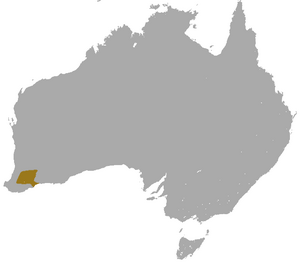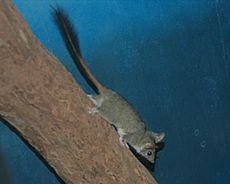Red-tailed wambenger facts for kids
Quick facts for kids Red-tailed phascogale |
|
|---|---|
 |
|
| Conservation status | |
| Scientific classification | |
| Genus: |
Phascogale
|
| Species: |
calura
|
 |
|
| Red-tailed phascogale range | |
The red-tailed phascogale (Phascogale calura) is a small, meat-eating marsupial. It is also known as the red-tailed wambenger. You can find this animal in parts of Central and Western Australia. It is closely related to the brush-tailed phascogale, but it is smaller and has browner fur.
Contents
What's in a Name?
Scientists group living things to understand them better. This is called taxonomy. The red-tailed phascogale belongs to the Phascogale group. There are three types of phascogales. These are the red-tailed phascogale, the brush-tailed phascogale, and the Northern brush-tailed phascogale.
A naturalist and artist named John Gould first described this animal in 1844. Its scientific name, Phascogale calura, means "beautiful-tailed pouched-weasel".
Meet the Red-tailed Phascogale
The red-tailed phascogale is smaller and browner than its close relative, the brush-tailed phascogale. These animals are good at climbing trees. They eat many different things. Their diet includes insects and spiders. They also hunt small birds and tiny mammals, like the house mouse. They get all the water they need from their food, so they do not need to drink.
Life Cycle and Survival
Male red-tailed phascogales have a very short life. They usually die after their first time mating. This happens because of stress-related illnesses. Most males do not live past 11 and a half months old. Females, however, can live up to three years in the wild. If they are kept in zoos, both males and females can live for up to five years.
Where They Live
The red-tailed phascogale used to live all over central and western Australia. Now, you can mostly find them in the southern Western Australian wheatbelt area.
They prefer to live in thick, tall forests. These forests often have Wandoo trees (Eucalyptus wandoo) and rock sheoak trees (Allocasuarina huegeliana). These plants make a chemical called fluoroacetate. This chemical is deadly to many animals, like farm animals. But red-tailed phascogales have learned to resist it. Most native Australian animals can resist this chemical. However, animals brought in by people, like the red fox, cannot. This might be why the red-tailed phascogale has survived in these areas.
Helping Them Survive
In 2009, some red-tailed phascogales were put back into the Wadderin Sanctuary in Western Australia. This was part of an effort to help them.
More recently, in June 2020, 30 phascogales were released at the Newhaven Wildlife Sanctuary in Central Australia. These animals came from a special breeding program at the Alice Springs Desert Park. Scientists carefully managed their breeding cycle. Before being released, each animal got a tiny microchip. This helps scientists track them and learn about their lives.
Protecting the Species
The red-tailed phascogale is classified as "Near Threatened" by the IUCN Red List. This means they could become endangered soon. The Australian EPBC Act lists them as "endangered". This means they are at high risk of disappearing forever.
See also
 In Spanish: Phascogale calura para niños
In Spanish: Phascogale calura para niños



